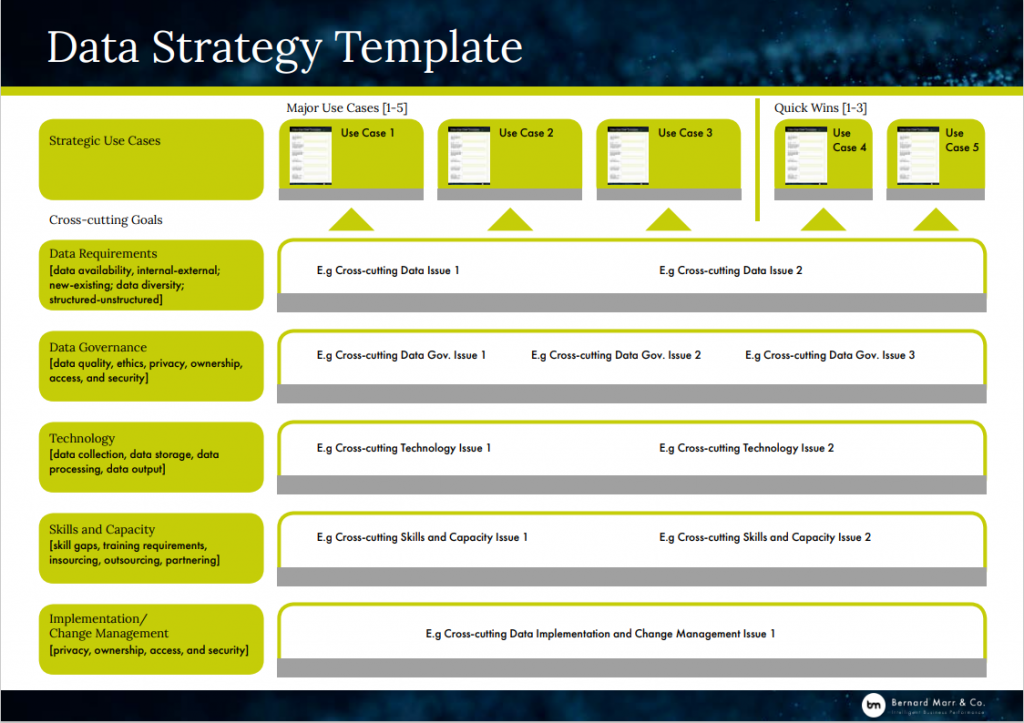Data Strategy: Way forward for Smarter Cloud Kitchens
20 MIN
What is Data Strategy?
The common thread for all digital transformation initiatives is data. Most of an organisation’s systems—from process flows to applications—rely on accurate and real-time data. This includes data quality management (such as pulling in data from various sources and cleansing it to ensure accuracy) as well as governance to ensure compliance with data privacy regulations. Today, data is one of the most valuable assets F&B companies must manage. Big data is shared across several different systems and grouped together in order to allow for relevant, profitable insights. Setting up a comprehensive, flexible big data strategy allows the company’s decision-makers to deal with all sort of issues and to deliver decisive competitive advantages. Nonetheless, F&B companies struggle to develop a data strategy that fits their needs.

Why bother with Data Strategy?
Myth: Data strategy costs more as it is tech-driven.
Moving towards a more data-driven culture is certainly attainable, and it starts with a variable data strategy. A data strategy is often viewed as a technical exercise, but a modern and comprehensive data strategy addresses more than the data. It is a road-map that combines 3 factors: People, Process, and Technology. The exercise of creating a data strategy is one in which organisation leaders take a deliberate look at:
- The people or employees needed so that they are empowered to use the data.
- The processes that ensure data is accessible and of high quality.
- The technology that will enable the storage, sharing and analysis of data.
A data strategy should lay out a detailed plan in order to mature in analytic capabilities and transition from making decisions based on hindsight to making decisions with foresight. As seen in the Gartner Analytic Ascendancy Model, the goal should be to move from using Descriptive Analytics (“What happened?”) to Prescriptive Analytics (“How can we make it happen?”).

Inefficiencies of data collection
The traditional way of collecting data from a restaurant’s customers has been through gathering feedback forms, conducting surveys, and asking for signups. These steps were considered an essential part of many customer lock-in strategies that aimed at ring fencing their customers. Over the years, technology has grown by leaps and bounds. This has made the collection of data for both customers and internal data management much easier. Simple, everyday activities such as browsing the internet, or placing an order online generate different sets of data which can reveal the eating habits, purchase preferences, travel habits and times of activity for users.
Marketers from other organisations are spending billions of dollars to crack this data in order to monitor consumer behaviour, analyse their spending patterns, and pitch the right kind of product at the right time through the right medium. However, this is missing from the F&B industry as the razor thin margins buries data analysis below their list of other priorities. This inevitably affects the level of expertise in the organisations.
How can You use Data Strategy?
Customer data management is crucial for your restaurant business as it reveals to you where you should be expanding your business. It tells you exactly which areas you need to push, help you plan customised campaigns and deliver better customer service.
Below, we recommend seven steps for companies to begin their data strategy journey. The seven steps are:
1. Access
The first stage in crafting a data strategy is to ask the simple question of where an organisation is currently in terms of data management. The current level of maturity can be discerned by what the business is able to actually do with data. A mature organisation will be able to gain, and act on, advanced customer insights gleaned from the available sources. Conversely, a less mature organization will likely be struggling to generate meaningful audience insights.
Here is a template (by Bernard Marr & Co.) that you can use to assess your data strategy maturity and the roadmap ahead.

2. Plan
With a good understanding of what questions the business is asking, we can turn to the next element: analysing data sources, how that data is gathered, and where the data exists. It doesn’t mean all data collection sources need to be digital. The fundamentals behind a data collection strategy need to be intact.
It’s unlikely that all data will be available within the organisation. It is less likely that it already exists in a place that’s accessible. So, we need to identify your primary and secondary sources of data. You must collect data from a variety of sources in order to reap the benefits of a data-driven strategy. Point-of-Sale (POS) Data, company financials, staff productivity, table turnaround time, popular dining/takeaway time and customer feedback can form part of your primary sources. Market intelligence reports, census data, google data, data published by associations are examples of secondary sources that you can consider.
Ask questions like:
- Should I remove menu items?
- Should I reduce menu price?
- Should I open a new outlet?
- Should I reward my manager?

3. Capture
Look at each question you’ve identified and then think about the ideal data you would want or need to answer that question. Once you have defined the ideal data, look inside the organisation to see what data you already have. Then look outside and establish what data you could have access to. The mix will depend on how much data can be acquired directly from your customers and how much is brought in through public sources.
For example, in order to decide on the removal of menu items, you can look at internal data sources such as basket mix or popularity. In the case that you don’t have a CRM that captures customer purchases, you can still have your manager ask the dining customers questions about why the dish was ordered or not.
The key is to be clear on which type of data is most useful in answering your business questions. Transactional data might be best suited to analyse purchase behavior, point redemption data might be used to analyse the frequency of repeated purchases at individual stores and surveys will give an indication on the brand’s health. When it comes to data, be explicit on the rationale behind capturing it.
4. Enrich
Very few organisations will have all the data they need to understand customers well enough to build highly defined audience segments. The key, then, is enrichment through additional data that helps you answer the business questions identified.
Using the example of removing menu items, let us assume you already have gathered internal and external data. Based on the results, you have found an irregularity with the pattern. Families with kids tend to order an item during dinner but the same segment does not order the same item during lunch. You add data from the average cooking time of the menu item and realise that it is usually served to the customers 30 minutes after the orders were placed. You discover that the segment tends to order set lunches which are served within 10 minutes of order. This means this item, while popular among kids, is usually the last to arrive during lunch. Thus, parents tend to order something different which is served faster. This is an example of data enrichment.
Another example would be the behavioural insights that a business has from on-site customer activities. This can be combined with online and offline purchasing data and then enriched through demographics and lifestyle signals from external sources. Cheesecake Factory has been working with IBM to enrich its regular data trove with new information about the characteristics of shipments of food supplies when they reach individual restaurants in their 177-outlet chain.
Data is only valuable if it helps to drive your understanding of customers and to help facilitate more meaningful targeting or engagement.
5. Manage
Enhanced data counts for little unless it is properly organised and managed. The first step is to gain a single view of your customers in the form of dashboard or reports. Even if your data collection strategy is airtight, you’ll still run into the problem of data decay over time. So, be sure to take the necessary steps to prioritise data maintenance. Organisations will only be able to derive relevant actionable insights only if the data is properly updated.
Questions to consider for good management of data:
- How long will you keep the data?
- How do you manage the security of your data?
- How do you organise your data in order to make it more accessible for different departments?
- How do you manage data from different silos?
- How do you manage data during system or application migration?
- How can you segment your customer base and protect the privacy of your customers?
6. Activate
Data activation is about drawing value out of your data. No data-driven strategy is complete without in-depth, accurate buyer personas. Based on the data you have collected, you can derive value by crafting buyer personas to help you understand your customers, their buying preferences, and much more. They allow you to tailor your entire omnichannel retail strategy to effectively attract more of your ideal customers. At this stage the crucial aspect is to think about how the data helps inform the right message, right place and right time in harmony. This essentially means using the data to personalise messaging across channels, devices and locations. Campaigns can then be optimised by understanding who has engaged with the brand on which devices and channels and how recent those interactions were and where.
In order to craft your ideal buyer persona, think about the ‘what’, ‘how’ and ‘why’ of your personas.
- What do your customers purchase? More specifically, what kinds of items do your ideal customers buy before or in addition to buying your items ? A person’s purchase history is a valuable piece of information as it can often help you to predict their future purchases.
- How do your customers make purchases? Do they prefer to buy items online, or in-store? Do they tend to buy in large quantities or purchase one item at a time? Understanding your customers’ buying preferences will help inform major strategic decisions concerning how you sell and market your products.
- Why do your customers make purchases? Psychographic data refers to seemingly unquantifiable characteristics such as a person’s personality traits, interests, motivators, values and hobbies. This type of data is typically collected through surveys, market research, and observation. To put it simply, demographics help you understand who a person is — their age, gender, location, etc. — but psychographics help you understand why customers buy what they buy.
7. Learn, Unlearn and Retrain
One common mistake when defining a data strategy is to consider it a one-time thing. Developing a data strategy is an ongoing, never-ending process. Effective data strategies never stand still, so there should be a constant flow of fresh insight back into the 360-degree view of each customer. Taking a static approach to your data strategy will only deepen the issues your strategy was meant to solve such as resource shortfalls, technical gaps, and missed opportunities. The key is to learn, unlearn and relearn from the insights that you have derives from your data.
Ask the following questions to validate your learning:
- Which data source is trustworthy?
- How to form a question to provide the specific result you want?
- How to improve the response for your surveys?
- Which part of the data process do you automate?
- How to better document data so that you can get insights?
- What is the ideal shelf life for data hygiene?
Only when you ask questions that are specific to your organisation, will there be enhanced insight accuracy and a process of continuous learning in place.

Prepare for the Future
As the on-demand food delivery economy continues to progress towards a projected $385 billion by 2030, it has also begun to reshape the global restaurant industry. As more and more consumers opt to stay home and press a button for food instead of going out, restaurant owners are increasingly choosing to forgo expensive real estate and front-of-house staff, and are instead expanding into virtual kitchens that cater exclusively to the on-demand audience.
To prepare for this, data strategy is a critical need. Those who will be able to create a comprehensive, sound data strategy will reap great benefits, both in the short and long term. They will find themselves in the right position to respond to the evolution of their needs and of the context surrounding them.
This transition from traditional to “virtual” restaurants may prove to be one of the defining platform shifts of our time. As the cloud kitchen market grows, so too will the demand for the technology that gets the food from the delivery-only commercial kitchens to consumers.


